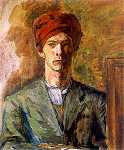
Born: 1897, St. Petersburg, Russia
Died: 1936, Warsaw, Poland
Early days. Father was an engineer. In 1907 his parents moved to Tbilisi, Georgia (then part of Russia) where Waliszewski spent his childhood. In Tbilisi he began studies in drawing and painting, in the School of Drawing and Painting. In 1908 he had his first exhibition and participated in the life of artistic avant-garde. During World War I he fought in the ranks of the Russian Army, returning to Tbilisi in 1917. He visited Moscow several times and became acquainted with the art of the Mir Isskustva (The World of Art).
Futurists. He became a member of a Futurist group and learned the tenets of avant-garde art. Toward the end of the 1920s he departed for Poland, and settled in Krakow in 1921.
Higher education. Between 1921 and 1924 he studied at Krakow's Academy of Fine Arts in the studios of Wojciech Weiss and Jozef Pankiewicz . In 1924 he went to Paris in the company of the members of the Paris Committee, which he founded, and continued his studies in painting there under the guidance of Pankiewicz.
Capists. He was a participant in the Capists' (from the Paris Committee) plein-air painting workshops in Cagnes, Valence, Cap Martin, and Avignon. At the Louvre he painted copies and travesties of the works of old masters like Titian, Veronese, Velasquez, Vermeer, Goya, and Delacroix. He was also fascinated by the art of CÚzanne, van Gogh, and Matisse. He participated in the first Capist exhibition at the Galerie Zak in Paris (1930) and took part in a presentation of the group's art organized somewhat later at the Galerie Moos in Geneva (1931).
Return to Poland. In 1931 he returned to Poland, residing in Warsaw, Krzeszowice, and Krakow. He exhibited his work in Warsaw at the Polish Artistic Club and salons organized by the Institute for Art Propaganda (1930, 1931, 1933, 1936). He also showed his work at the galleries of the Friends of the Fine Arts Societies in Krakow, as well as in Lwow, Poznan, and Lodz. In 1935 and 1936, he decorated the ceiling of the Kurza Stopka (Chicken's Foot) Tower at Wawel Castle in Krakow.
The work Waliszewski did while in Tbilisi (1917-1921) was influenced by French painting of the time - significant amounts of which he saw in various private collections - and by the art of the Russian avant-garde. During this time Waliszewski designed scenery and posters, created book illustrations, drew and painted caricatures and grotesque scenes. In Krakow he befriended the Formists, with whom he shared a tendency to accentuate the structure of his paintings and to render natural forms geometrically. He painted primarily portraits and figural compositions with a grotesque flavor and landscapes of the villages of Mory and Kazimierz. Believing that a new vitality could be extracted from primitive art, he also looked to common crafts and folk art for stylistic patterns.
His early oil paintings, created while he was in Cagnes (1925), were characterized by thickly applied materials, dark color schemes, a flatness characteristic of the decorative arts, and rhythmic composition. In his still lifes dating from 1929-1931 harmonized pure hues enliven otherwise contrasting cold and warm colors and areas of color laid with a high degree of freedom define forms. These works exhibit the recognizable inspiration of Odilon Redon and his phenomenal and highly decorative images of flower bouquets.
Waliszewski painted numerous views of Warsaw and Krakow, showed a partiality to portraits and a fascination for nudes. Contrary to other Capists he did not avoid the descriptiveness inherent in drawing and literary narration in painting. His series UCZTY RENESANSOWE / RENAISSANCE FEASTS consists of pastiches of the monumental compositions of Paolo Veronese. He composed often fantastic, Comedia dell'arte inspired scenes and numerous variations on the motif of Don Quixote. He filled his paintings with humor, comic situations, derision, and irony, and was quick to paraphrase, travesty, and render theatrical the styles of various periods and iconographic and literary motifs. In the series ARLEKINY/HARLEQUINS and WYSPY MILOSCI / ISLES OF LOVE , he subjected the visible world to grotesque stylization. Using small, choppy brushstrokes, he painted flat, decorative compositions that vibrate with pure colors and are characterized by symbolic portrayals of figures and objects additionally outlined with light contours.
Despite of his modest resources and a prolonged illness his art is full of joy of life. Shortly before his death he painted the plafond in Kurza Stopka (Wawel castle in Cracow). He died suddenly in 1936.
Based on the article by Irena Kossowska from the Institute of Art of the Polish Academy of Science December 2001 with the permission from Andrzej Lubomirski from the Adam Mickiewicz Institute,
Centre for International Culture Cooperation. See:
Irena Kossowska
Also see:
Poznan
Waliszewski's paintings
Return to home page:
Prominent Poles